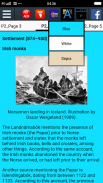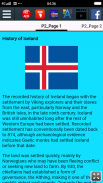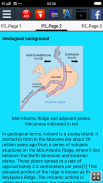








History of Iceland

توضیحات History of Iceland
The recorded history of Iceland began with the settlement by Viking explorers and their slaves from the east, particularly Norway and the British Isles, in the late ninth century. Iceland was still uninhabited long after the rest of Western Europe had been settled. Recorded settlement has conventionally been dated back to 874, although archaeological evidence indicates Gaelic monks had settled Iceland before that date.
The land was settled quickly, mainly by Norwegians who may have been fleeing conflict or seeking new land to farm. By 930, the chieftains had established a form of governance, the Althing, making it one of the world's oldest parliaments. Towards the end of the tenth century, Christianity came to Iceland through the influence of the Norwegian king Olaf Tryggvason. During this time Iceland remained independent, a period known as the Old Commonwealth, and Icelandic historians began to document the nation's history in books referred to as sagas of Icelanders. In the early thirteenth century, the internal conflict known as the age of the Sturlungs weakened Iceland, which eventually became subjugated to Norway through the Old Covenant (1262–1264), effectively ending the commonwealth. Norway, in turn, was united with Sweden (1319) and then Denmark (1376). Eventually all of the Nordic states were united in one alliance, the Kalmar Union (1397–1523), but on its dissolution, Iceland fell under Danish rule. The subsequent strict Danish–Icelandic Trade Monopoly in the 17th and 18th centuries was detrimental to the economy. Iceland's subsequent poverty was aggravated by severe natural disasters like the Móðuharðindin or "Mist Hardships". During this time the population declined.
Iceland remained part of Denmark, but in keeping with the rise of nationalism around Europe in the nineteenth century an independence movement emerged. The Althing, which had been suspended in 1799, was restored in 1844, and Iceland gained sovereignty after World War I, on 1 December 1918. However Iceland shared the Danish Monarchy until World War II. Although Iceland was neutral in the Second World War, the United Kingdom peacefully occupied it in 1940 to forestall a Nazi occupation, after Denmark was overrun by the German Wehrmacht. Because of the island's strategic position in the North Atlantic, the allies occupied the island until the end of the war, the United States taking over occupation duties from the British in 1941. In 1944, Iceland severed its remaining ties with Denmark (then still under Nazi occupation) and declared itself a fully independent nation. Following the Second World War, Iceland was a founding member of both the United Nations and the North Atlantic Treaty Organization. Its economy grew rapidly largely through fishing, although this was marred by conflicts with other nations.
Following rapid financial growth, the 2008–11 Icelandic financial crisis occurred. Iceland continues to remain outside the European Union.
Because of its remoteness, Iceland has been spared the ravages of European wars but has been affected by other external events, such as the Black Death and the Protestant Reformation imposed by Denmark. Iceland's history has also been marked by a number of natural disasters.
Iceland is a relatively young country in the geological sense, being formed about 20 million years ago by a series of volcanic eruptions in the Mid-Atlantic Ridge. The oldest stone specimens found in Iceland date back to ca. 16 million years ago.
تاریخ ثبت ایسلند با حل و فصل شده توسط وایکینگ کاشفان و بردگان خود را از شرق، به ویژه نروژ و جزایر بریتانیا، در اواخر قرن نهم آغاز شد. ایسلند هنوز هم غیر مسکونی بود مدت ها پس از بقیه اروپا غربی حل و فصل شده است. حل و فصل را ثبت کرده است مرسوم به 874 مورخ شده است، اگر چه شواهد باستان شناسی نشان می دهد راهبان اسکاتلندی ایسلند قبل از آن تاریخ حل و فصل بود.
زمین به سرعت به طور عمده توسط نروژی که ممکن است در حال فرار است و یا به دنبال درگیری سرزمین جدید به مزرعه حل و فصل شد. توسط 930، که رؤسا شکلی از حکومت، آلثینگی تاسیس شده بود، و آن را یکی از قدیمی ترین مجالس در جهان است. در اواخر قرن دهم، مسیحیت به ایسلند را از طریق نفوذ پادشاه نروژی اولاف Tryggvason آمد. در طول این زمان ایسلند مستقل باقی ماند، یک دوره شناخته شده به عنوان مشترک المنافع قدیمی، و مورخان ایسلندی شروع به سند تاریخ کشور در کتاب به عنوان سرگذشتنامههای ایسلندی مراجعه کننده به. در اوایل قرن سیزدهم، درگیری های داخلی شناخته شده به عنوان سن Sturlungs تضعیف ایسلند، که در نهایت به نروژ از طریق میثاق قدیمی (1262-1264) تحت انقیاد شد، به طور موثر پایان دادن به کشورهای مشترک المنافع. نروژ، به نوبه خود، با سوئد (1319) و سپس دانمارک (1376) متحد شد. در نهایت همه از کشورهای شمال اروپا در یک اتحاد، اتحاد کالمار (1397-1523) متحد شدند، اما در انحلال آن، ایسلند تحت حکومت دانمارکی سقوط کرد. پس از آن سخت دانمارکی ایسلندی تجارت انحصار در قرن 17 و 18 مخل به اقتصاد بود. فقر پس از آن ایسلند از بلایای طبیعی شدید مانند Móðuharðindin یا "مه سختی ها" رو به وخامت گذاشت. در طول این زمان جمعیت کاهش یافته است.
ایسلند بخشی از دانمارک باقی ماند، اما در همراهی با رشد ناسیونالیسم در سراسر اروپا در قرن نوزدهم یک جنبش استقلال پدید آمده است. آلثینگی، که در سال 1799 متوقف شده است، در سال 1844 بازسازی شد و ایسلند حاکمیت پس از جنگ جهانی اول، دسامبر 1918. به دست آورد در 1 با این حال ایسلند دانمارکی سلطنت تا جنگ جهانی دوم به اشتراک گذاشته. اگر چه ایسلند در جنگ جهانی دوم بی طرف بود، انگلستان مسالمت آمیز آن را در 1940 اشغال برای ممانعت از اشغال نازی ها، پس از دانمارک توسط ارتش آلمان تاخت و تاز بود. به دلیل موقعیت استراتژیک جزیره در اقیانوس اطلس شمالی، متحدان جزیره تا پایان جنگ اشغال، ایالات متحده مصرف بیش از وظایف شغل از بریتانیا در سال 1941. در سال 1944، ایسلند روابط باقی مانده خود را با دانمارک قطع (که هنوز در اشغال نازی ها) و خود را یک ملت به طور کامل مستقل اعلام کرد. پس از جنگ جهانی دوم، ایسلند یکی از اعضای موسس هر دو سازمان ملل متحد و سازمان پیمان آتلانتیک شمالی بود. اقتصاد آن به سرعت در حال رشد تا حد زیادی از طریق ماهیگیری، اگر چه این با درگیری با دیگر کشورها خدشه دار شد.
زیر رشد مالی سریع، 2008-11 بحران مالی ایسلندی رخ داده است. ایسلند همچنان به خارج از اتحادیه اروپا باقی مانده است.
از آنجا که از دور بودن آن، ایسلند است از نابسامانی های جنگ های اروپایی در امان مانده است اما توسط سایر رویدادهای خارجی، مانند مرگ سیاه و اصلاحات پروتستانی اعمال شده توسط دانمارک متاثر شده است. تاریخ ایسلند نیز توسط تعدادی از بلایای طبیعی مشخص شده اند.
ایسلند یک کشور نسبتا جوان در معنای زمین شناسی است، که حدود 20 میلیون سال پیش توسط یک سری از فوران های آتشفشانی در اقیانوس اطلس اواسط یال تشکیل شده است. قدیمی ترین نمونه های سنگ پیدا شده است در ایسلند به تاریخ حدود 16 میلیون سال پیش است.

























